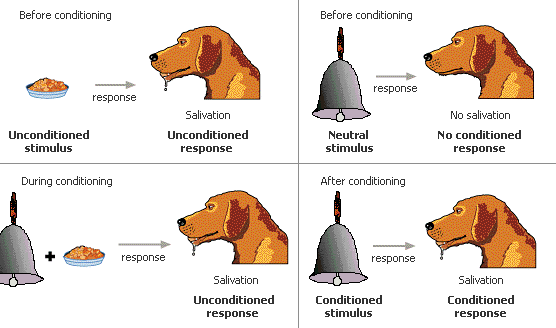Classical Conditioning
Classical conditioning occurs in learning when a neutral stimulus correlates with a stimulus and causes a behavior. A Russian physiologist, Ivan Pavlov came up with this theory after he noticed the dogs salivating every time the lab technicians entered the room. He realized that the dogs salivated when the lab technicians entered the room, because they knew they were getting fed. Pavlov then associated the time the dogs ate and rang a bell every time they were about to be fed. Overtime, the dogs salivated to the ring of the bell. The unconditioned response is something that causes a natural response, in this case it would be the dogs food. The unconditioned response occurs naturally after the unconditioned stimulus. The unconditioned response is the salvation of the dogs. The conditioned response is the desired response and it is the dogs salivating to the bell ringing in Pavlov's experiment and the learned behavior by the dogs. This research by Pavlov showed people how to understand learning.

Here is a youtube video of another example of classical conditioning from the show The Office!
https://www.youtube.com/watch?v=XYgY-Y4NoLo
Reference:
[Author removed at request of original publisher]. (2015, October 26). Introduction to Psychology. Retrieved from http://open.lib.umn.edu/intropsyc/chapter/7-1-learning-by-accociation-classical-conditioning/

I like how you explained what classical conditioning is and gave an example from a tv show. I feel like real life examples make it easier to learn what things are especially in psychology. When I first learned about classical conditioning it was hard for me to grasp, but the example you used and how you explained everything could have helped me when first learning about this.
ReplyDelete